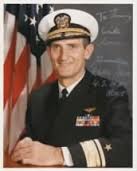TAHLER-GRAHAM
GRAHAM "HAM" TAHLER

RADM

DECORATED WWII NAVAL AVIATOR
Graham Tahler was born on March 2, 1921, in Forest Hills, New York. He attended public schools in New York City and studied at Queens College before joining the Navy in 1942. He received his wings in September 1942 and became the pilot of a Grumman TBF torpedo bomber. He became a decorated naval aviator when awarded the Distinguished Flying Cross in March 1944 for actions in the Solomon Islands during which he took part in 41 strikes and special missions against Japanese installations. For action in July 1945 he was awarded the Navy Cross for his actions in bombing a Japanese battleship at Kure, Japan. Historical records report he flew more than 140 carrier takeoffs during World War II, participating in combat missions in numerous locations including the Solomon Islands, Okinawa and Japan.
During an interview one of Tahler’s relatives stated he told the story that while flying over Japan immediately after the Japanese surrender his enlisted man gunner encouraged him to land although pilots had not yet been allowed to land on Japanese soil. Being a young eager pilot he decided to disregard the order and landed so his gunner could jump out of the plane and grab two handfuls of grass. Immediately taking off they returned to their ship where Admiral John S. McCain Sr., the Task Force Commander, witnessed the gunner returning with a handful of grass but instead of reprimanding them merely turned around and sat down.
Following World War II, Tahler remained in the Navy and returned to college where he graduated from Columbia University. This was followed by a series of assignments including duty with the Navy’s bureaus of personnel and operations, command of a Naval air training unit in Memphis, service on the staff of the Chief of Naval Air Training, deputy to the president of the Naval War College, assistant chief for Naval Reserve in the Bureau of Personnel and lastly as Commandant of the Sixth Naval District. He retired with the rank of Rear Admiral in 1974.
RADM Graham Tahler died of leukemia on October 31, 1998, at Bethesda Naval Medical Center and has been interred at Arlington National Cemetery.
DISTINGUISHED FLYING CROSS CITATION
“In the name of the President of the United States, the Commander South Pacific Area and South Pacific Force takes pleasure in awarding the Distinguished Flying Cross to Lieutenant Graham Tahler for extraordinary achievement while participating in aerial flight as pilot attached to a torpedo bombing squadron operating in the Solomon Islands area during the period from September 13, 1943 to March 5, 1944. In three tours of duty, Lieutenant Tahler took part in forty-one strikes and special missions against heavily defended airfields and ground installations in this area. On most of these missions, he was subjected to intense anti-aircraft fire and enemy fighter plane opposition. On February 17, in a bombing attack against enemy shipping in Rabaul Harbor, he obtained a direct hit on an enemy transport. His outstanding skill and courageous devotion to duty contributed materially to the severe damage inflicted on the enemy and to the neutralization of Japanese airfields throughout the area. His conduct throughout was in keeping with the highest traditions of the United States Naval Service.”
NAVY CROSS CITATION
“The President of the United States of America takes pleasure in presenting the Navy Cross to Lieutenant Graham Tahler for extraordinary heroism in operations against the enemy while serving as Pilot of a carrier-based Navy Torpedo Plane in Torpedo Bombing Squadron EIGHTY-FIVE (VTB-85), attached to the U.S.S. SHANGRI-LA (CV-38), during action against enemy Japanese Fleet units at Kure, Japan, 28 July 1945. Lieutenant Tahler pressed his attack home in spite of intense anti-aircraft fire from heavy combat ships and shore batteries and releasing his four five-hundred pound bombs at low altitude, scored a direct hit on the stern of the battleship HARUNA and one very near miss, damaging her severely. The flight to the target and return was completed in extremely adverse weather marked by very low ceiling, rain and restricted visibility. His skillful airmanship, intrepid spirit and devotion to duty were in keeping with the highest traditions of the United States Naval Service.”
Submitted by CDR Roy A. Mosteller, USNR (Ret)

